Summer Conservation And Maintenance Program
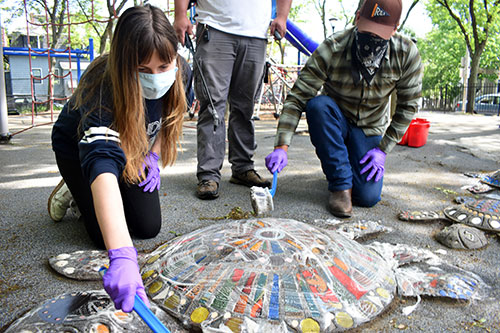 The City of Cambridge has more than 280 works of contemporary public art, and Cambridge Arts takes care of them to preserve them for the future. Each spring our Conservation And Maintenance Program (CAMP) inspects, treats and cleans more than half of them. Meet the Conservation Art Maintenance Program team for 2022:
The City of Cambridge has more than 280 works of contemporary public art, and Cambridge Arts takes care of them to preserve them for the future. Each spring our Conservation And Maintenance Program (CAMP) inspects, treats and cleans more than half of them. Meet the Conservation Art Maintenance Program team for 2022:
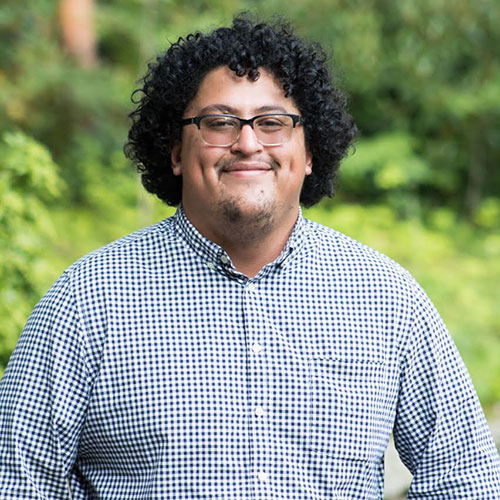
Daniel Carlson-Strom
Art Conservation Technician
Worked with Cambridge Arts during summers since 2019
Work experience:
The most interesting job was actually an internship at Plimoth Patuxet (formally known as Plimoth Plantation). I interned on the native side and learned so much about the Wampanoag people. I was the first intern ever to go on a bark trip to collect bark for the wetu that Plimoth was building. I’ve worked with Cambridge Arts for three years now. From 2019 to present. It’s been a blast, everyone on the team is incredible and works well together.
Skills (specialties, super powers, secret talents, etc.):
I guess one of my skill sets is baking. During quarantine, I spent those months baking desserts. Chocolate cake, scones, strawberry crisp, peach cobbler, apple pie, etc.
Are you an artist?
As a matter of fact, I am not an artist. My mother and brother are, but I am not. I have helped install and take down galleries in the past but as for creating art, it’s not my thing.
Favorite public artwork(s) in the Cambridge collection?
My favorite public artwork is the huge desk by Mags Harries at Longfellow Elementary School. Makes me feel like I'm a kid again and I'm on the Magic School Bus when it shrinks.
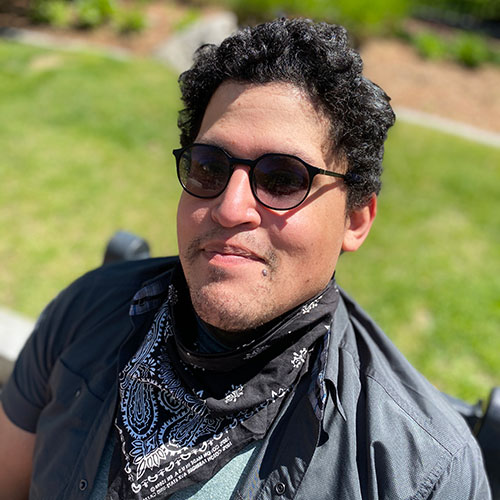
Joseph Carlson-Strom
Conservation and Maintenance Technician
Worked with Cambridge Arts during summers since 2018
Work experience:
Before Cambridge Arts, I was an installer for the SMFA. I would transport the graduate students’ thesis work to the gallery and assist with individual installations. I’ve also worked as a western swing dance instructor.
Skills (specialties, super powers, secret talents, etc.):
I have too many to list but here are a few: Voted #1 Cambridge Arts van DJ three years running, swing dancer, rock climber, super strength, grill master, can beat anyone at “Mario Kart,” master waxer and buffer, just #1 overall, and finally aspiring professional kite flyer.
Are you an artist?
Outside of work I’m a freelance composer and art handler/installer. For the music work I compose guitar pieces and occasionally perform my original music for public art projects and performances In Montana. As for the art side I install shows for a number of art galleries and also ship/transport work across the country.
Favorite public artwork(s) in the Cambridge collection?
My favorite piece in the collection would be “Light Shadow: MLK” by Christopher Janney at the MLK elementary school. It’s a wall filled with LEDs, speakers and over 200 sensors. The sensors are activated when you walk by causing the LEDs to light up while a wide range of chimes and sounds play through the speakers. I’m a huge fan of interactive work. It’s such an amazing feeling to be able to physically move and interact with sound installations.
What is something you learned about a public artwork in the Cambridge collection by working on it? Something that people may not know just from looking at it?
I’ve learned an incredible amount about Cambridge while working in and around the public but one experience sticks out to me. While working on the piece “Pole Climbers” at the Columbia Street park, a man approached me and asked if I knew what the sculpture was about. I replied that I actually didn't know, and he told me his story about growing up here in Cambridge and playing the sport this sculpture honors. This sport was pole/mast climbing where kids and local residents would climb a 12-foot-tall greased pole competitively. The whole community would get together, cook food and watch these competitions. I hope these interactions happen again in the near future.
Tatiana Shannon
Work experience:
I graduated from Hampshire College in 2012, and spent approx 3.5 years doing an internship in picture frame conservation with the Smith College Museum of Art and getting my academic prerequisites in chemistry wrapped up. Following that I have job/internship hopped quite a bit, working for the Mark Twain House & Museum, Central Park Conservancy, Excelsior Art Services LLC, the Museum of African American History in Boston, etc. For the past 3+ years I have been interning with Sculpture and Decorative Arts Conservation Services - owned by Barbara Mangum. While the bulk of my experience is in object conservation (with a bit of preventative conservation/collections management experience), I also started a part-time paintings conservation internship in late June of this year.
Skills (specialties, super powers, secret talents, etc.):
I'm a bit of a late 19th century history nerd, and I'm in an Italian-language choir (I do not speak Italian sadly, but it is on my list of things I'd like to learn given infinite time and resources).
Are you an artist?
I have been taking classes in woodworking and enamelling on metal for several years (somewhat interrupted by the pandemic but have resumed classes now). I am currently working quite hard at mastering the fundamentals of plique-a-jour in my enamelling class.
Favorite public artwork(s) in the Cambridge collection?
"Birds" by Juliet Kepes and "Light Shadow: MLK" by Christopher Janney are amongst my favorites.
Craig Uram
Director of Art Conservation
Work experience:
After studying sculpture at Boston University, I worked with artist Lloyd Lillie, casting his life-sized sculptures into wax in preparation for the bronze castings of “First Wave” that are installed in the lobby of the Visitors Center of the Women’s Rights National Historic Park in Seneca Falls, New York. I also spent several years working in a frame shop in Brookline Village. From there I joined Harvard University’s Art Museums as their framer/preparator of Works on Paper. I went on to study Art Conservation, with a focus on sculpture, at Buffalo State College. I did internships and fellowships at the Hirshhorn Museum and Sculpture Gardens, the Carnegie Museum of Art, Historic New England, Harvard Art Museums, and the Isabela Stewart Gardner Museum. I have worked as an Object Conservator at the Museum of Fine Arts, Boston and the Smithsonian’s National Museum of African American History and Culture, and as a Preparator and Collections Specialist at the Davis Museum at Wellesley College.
Skills (specialties, super powers, secret talents, etc.):
I have played drums since I was 12 years old. I was in several local bands, including Rockets Burst from the Streetlamps. I also was a touring drummer with the solo electronica artist, Chop Chop. I’ve also been featured in a few short films.
Are you an artist?
I studied as a sculptor at Boston University and continued to make sculptures, but alas, the time commitment for taking care of other artists work and raising a child have proven too much, and I have not made any art for the last ten years. I hope to get back to making art again at some point.
Favorite public artwork(s) in the Cambridge collection?
I’m a big fan of the traditional materials of sculpture; stone, bronze, wood, and glass though I also appreciate the use of more modern materials from construction, such as cement and steel. I studied art with an emphasis on the figure. My own work was more minimal, but never abandoned the figure. I am drawn to the sculpture of the Modernists and the Minimalists, with a great appreciation for attention to construction and a post-minimalist aesthetics. I love to see the artist’s hand in their creation. My favorite pieces in the Cambridge collection reflect that approach: Gene Cauthen’s, Workers and other figurative pieces, Madeline Lords, Revolutionary Figures, Vusumuzi Maduna’s Totems, David Phillips Spiral and Stone Work, and Godfrey Dewitt’s Quake. And I am also enthusiastically awaiting the upcoming installation of Mark Reigelman’s monumental Corten Steel sculpture of a deer in Inman Square, which I am sure will be a big hit.
What is something you learned about a public artwork in the Cambridge collection by working on it? Something that people may not know just from looking at it?
The close study always brings a new knowledge and appreciation, and I am constantly learning new things about the collection. It’s always interesting to me to learn how the public artworks are made, from the materials to the fabrication methods, from finishes to paint systems. I work with the artists to choose these materials and methods that will last and be manageable from a maintenance standpoint so that they will last. Look closely at pieces such as Bland Hoke’s Artesian Well, Vivian Beer’s, Thunderhead, Nancy Selvage’s, Water Wall, and Beth Galston’s, Shadow Walk. They are all the same material, stainless steel, but all take different approaches to finishing, from sandblasting to grinding. And in each one the material used to achieve the finish is thought about carefully, from the size and type of the particle (sand, walnut, chalk) used to blast finish to the grit used when grinding to the tool used for finishing. And all the minute decisions effect the overall aesthetic, as well as the ease of maintenance and preservation.
Meet Conservation Art Maintenance Program team from 2021:
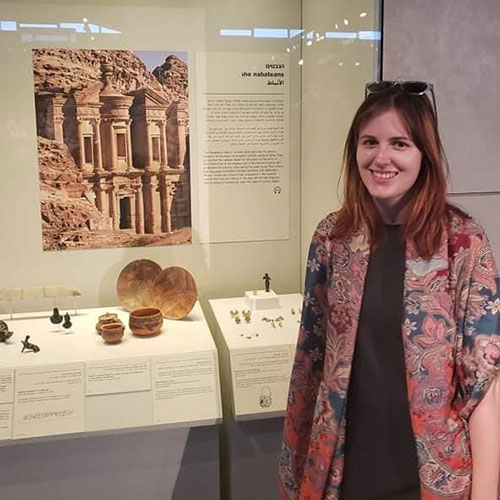
Michelle Heeman
Conservation Technician
Worked with Cambridge Arts during the summers of 2019 and 2021
Work experience:
As an archaeologist specializing in the ancient Mediterranean world, I have worked on excavations in the Middle East for several years now, primarily in Jordan and Israel, but I have also worked in North America. While archaeology is most of what I do, I also have training in museum studies and art conservation. I have worked as an archival and curatorial intern at both my undergraduate university and at my hometown's historical society, and in 2017, I interned at the Royal Ontario Museum in Toronto, Canada, in the ceramics, stone, and glass objects laboratory. Most recently, I have trained in photogrammetry and 3-D modeling as an assistant to my research adviser at Brandeis University, which I am excited to bring to my work with museum objects and artwork in the future!
Skills:
Artifacts care, objects photography, photogrammetry and 3-D modeling, and, of course, digging!
Specialties, super powers, secret talents, etc.:
I make a mean shakshuka!
Are you an artist?
No, I don't consider myself an artist, but as an archaeologist, I often work with ancient objects and artworks both on-site and in the lab.
Favorite public artwork(s) in the Cambridge collection?
My favorite public artworks in the collection are the Japanese-inspired sculptures at the Franklin Street Park near Harvard Square.
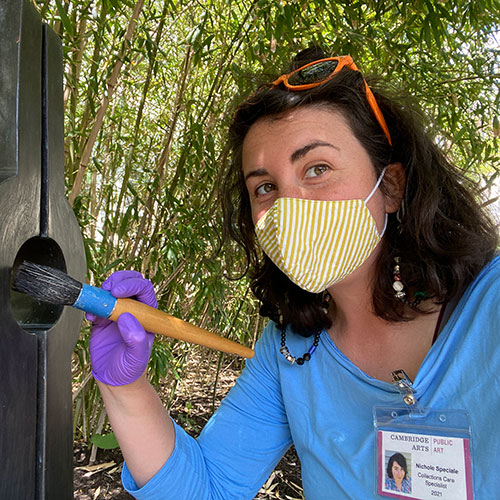
Nichole Speciale
Collections Care Specialist
Worked with Cambridge Arts since 2016
Work experience:
I've worked on many art conservation projects in the Boston area including cleaning the Lilli Ann Rosenberg mosaic in the Park Street Green Line Station, restoring the “Beat the Belt” mural on the Micro Center, treating the Nicole Eisenman bronzes in front of the Landmark Center (now 401Park) and cleaning and in painting the Tony Smith sculpture at MIT. In addition to my work at Cambridge Arts, I do book preservation for the Brandeis Library and have a small illustration business called Yellow Ochre Studio.
Skills (specialties, super powers, secret talents, etc.):
The Cambridge Arts team tells me my superpower is parallel parking, I think I can concur. To add to that, I am great with a spreadsheet, I am a good cook, and I just became a Master Gardener in the state of Rhode Island.
Are you an artist?
I am a visual artist and I have a wide variety of artwork that spans from landscape collage to embroidery and sewing to sound. I'm a little behind on website updates, but you can get a sense of past projects here: https://www.nicholelizspeciale.com/ and I often post newer work on my instagram:
@nicholelizspeciale.
Favorite public artwork(s) in the Cambridge collection?
“Salmones Salari (The Great Leaper),” a fountain by Andreas Von Huene in Lowell School Park, because it creates such a wonderful quiet spot to contemplate, and Ellen Driscoll's “Filament/Firmament” at Cambridge Public Library because of the way she uses weaving and sewing on a large scale to represent women's historic contribution to civic life, an idea that relates closely to my own artwork.
What is something you learned about a public artwork in the Cambridge collection by working on it? Something that people may not know just from looking at it?
In the past few years, I have learned a lot about Mierle Laderman Ukeles' piece “Turnaround/Surround” on the top of the hill at Danehy Park. Mierle's work often calls attention to the unseen labor in municipalities, like trash collection. Danehy, as many know, used to be a landfill, so in the path that runs through the piece at the top of the hill Mierle embeds bits of glass collected from Cambridge recycling to create an upgraded asphalt path and call attention to what lies below the park. She also worked with the city arborist to choose specific grass plantings that signal landscape regeneration and aromatic flowers and herbs to remediate the smell of garbage that stood for so long.
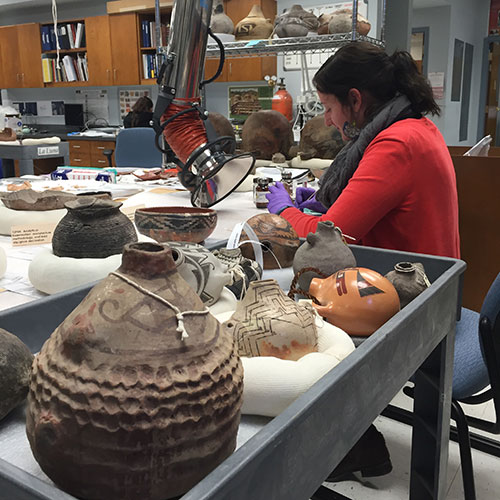
Mary T. Vigliotti
Principle Staff Assistant by day and Contract Conservator by night
Worked with Cambridge Arts summers of 2018 and 2021
Work experience:
I love working with Cambridge Arts! We have a great team of people! I have also been lucky enough to work with museums/private conservators both in the US and UK. My pre-program conservation experience was working with arms and armor at the Higgins Armory Museum, which is now part of the Worcester Art Museum. That experience was very special, and was my introduction to the field.
Skills (specialties, super powers, secret talents, etc.):
I went to graduate school for conservation in England, with a focus on ceramics, glass, and stone.
Are you an artist?
I studied studio art in undergrad, although my focus has shifted since then, I still love taking out my camera and making pottery.
Favorite public artwork(s) in the Cambridge collection?
Too many to choose from! I do love the Igor Fokin Memorial.
What is something you learned about a public artwork in the Cambridge collection by working on it? Something that people may not know just from looking at it?
I think the best part of treating public art is that you’re placed in the community, and you’re working in neighborhoods. It gives the opportunity to speak with people in that area who may approach you while working, and starts a dialogue about community art.